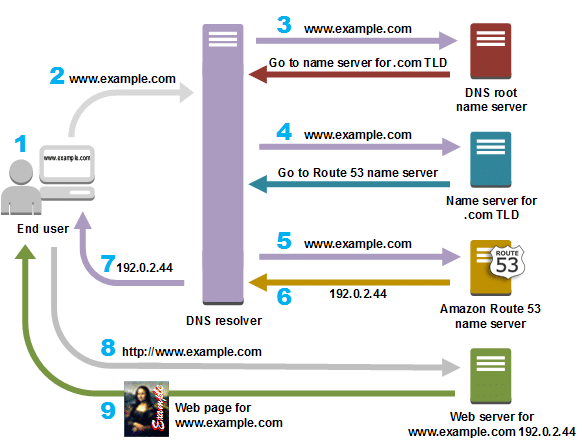(based on information published on AWS official website)
DNS, or Domain Name System, translates human-readable domain names (for example, www.amazon.com) to machine-readable IP addresses (for example, 192.0.2.44).
DNS explained
All computers on the Internet that serve content for massive retail websites, find and communicate with one another by using numbers. These numbers are known as IP addresses. When you open a web browser and go to a website, you don’t have to remember and enter a long number. Instead, you can enter a domain name like example.com and still end up in the right place.
A DNS service such as Amazon Route 53 is a globally distributed service that translates human-readable names like www.example.com into the numeric IP addresses like 192.0.2.1. Computers use these numbers to connect with each other. The Internet’s DNS system works much like a phone book by managing the mapping between names and numbers. DNS servers translate requests for names into IP addresses, controlling which server an end-user will reach when they type a domain name into their web browser. These requests are called queries.
Types of DNS service
Authoritative DNS: An authoritative DNS service provides an update mechanism that developers use to manage their public DNS names. Amazon Route 53 is an authoritative DNS system.
Recursive DNS: Clients typically do not make queries directly to authoritative DNS services. Instead, they generally connect to another type of DNS service known a resolver, or a recursive DNS service. A recursive DNS service acts as a hotel concierge: while it doesn’t own any DNS records, it acts as an intermediary who can get the DNS information on your behalf. If a recursive DNS has the DNS reference cached or stored for a period of time, then it answers the DNS query by providing the source or IP information. If not, it passes the query to one or more authoritative DNS servers to find the information.
What is Amazon Route 53?
Amazon Route 53 provides a highly available and scalable Domain Name System (DNS) Server. Its design purpose is to give developers and businesses an extremely reliable and cost-effective way to route end users to Internet applications. Route53 effectively connects user requests to infrastructure running in AWS – such as Amazon EC2 instances, Elastic Load Balancing load balancers or Amazon S3 buckets. It also routes users to infrastructure outside of AWS.
What can I do with Amazon Route 53?
With Amazon Route 53, you can create and manage your public DNS records. Like a phone book, Route 53 lets you manage the IP addresses listed for your domain names in the Internet’s DNS phone book. Route 53 also answers requests to translate specific domain names like into their corresponding IP addresses like 192.0.2.1. You can use Route 53 to create DNS records for a new domain or transfer DNS records for an existing domain. The simple, standards-based REST API for Route 53 allows you to easily create, update and manage DNS records. Route 53 additionally offers health checks to monitor the health and performance of your application as well as your web servers and other resources. You can also register new domain names or transfer in existing domain names to be managed by Route 53.
How Route 53 routes traffic to your web application
The following diagram gives an overview of how recursive and authoritative DNS services work together to route an end user to your website or application.



Operation flow
- A user opens a web browser, enters www.example.com in the address bar, and presses Enter.
- The request for www.example.com is routed to a DNS resolver, which is typically managed by the user’s Internet service provider (ISP), such as a cable Internet provider, a DSL broadband provider, or a corporate network.
- The DNS resolver for the ISP forwards the request for www.example.com to a DNS root name server.
- The DNS resolver for the ISP forwards the request for www.example.com again, this time to one of the TLD name servers for .com domains. The name server for .com domains responds to the request with the names of the four Amazon Route 53 name servers that are associated with the example.com domain.
- The DNS resolver for the ISP chooses an Amazon Route 53 name server and forwards the request for www.example.com to that name server.
- The Amazon Route 53 name server looks in the example.com hosted zone for the www.example.com record, gets the associated value, such as the IP address for a web server, 192.0.2.44, and returns the IP address to the DNS resolver.
- The DNS resolver for the ISP finally has the IP address that the user needs. The resolver returns that value to the web browser. The DNS resolver also caches (stores) the IP address for example.com for an amount of time that you specify. Next time someone browses to example com, it can respond more quickly. For more information, see the time to live (TTL).
- The web browser sends a request for www.example.com to the IP address that it got from the DNS resolver. This is where your content is. For example, a web server running on an Amazon EC2 instance or an Amazon S3 bucket is configured as a website endpoint.
- The web server or another resource at 192.0.2.44 returns the web page for www.example.com to the web browser. The web browser displays the page.
Benefits of using Amazon Route 53
- Highly available and reliable
- Flexible
- Designed for use with other Amazon Web Services
- Simple
- Fast
- Cost-effective
- Secure
- Scalable
What is the price of Amazon Route 53?
Amazon Route 53 charges are based on actual usage of the service for Hosted Zones, Queries, Health Checks, and Domain Names. For full details, see the Amazon Route 53 pricing page.
You pay only for what you use. There are no minimum fees, no minimum usage commitments, and no overage charges. You can estimate your monthly bill using the AWS Simple Monthly Calculator.
Get started with Amazon DNS Route 53
For those who want to get started with Amazon Route 53 on their own visit the FAQ section for manuals and detail.
Good news for our AWS Cloud hosting clients! The only thing you need to do is to let us know you want to switch to Route 53. Consider it done! You will save time, money, and effort. And it will work properly.
Ready for Route 53?

